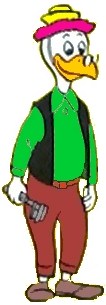 |
When
Barks dreamt up Duckburg's finest inventor, Gyro
Gearloose, he was only supposed to be an
occasional visitor to the stories. Later, after
the character became enormously popular, Barks
expressed his vexation that he had not drawn him
in a simpler way, i.e. without hair, hat,
spectacles and waistcoat. I
needed a guy with lots of inventions. I had
thought I would have old Gyro in one or two
stories. If I had known he was eventually going
to have a book of his own, I would have made him
a character that was easier to draw. He is quite
tall, and it's awkward to use a tall character
along with the ducks, who are only about two feet
high. I would made him a funnier looking
character and put more thought about the
development of his character into the actual
drawing of him.
I
just deliberately invented Gyro as a crazy
inventor. I only figured on using him once in a
very great while, so I just made him a big
awkward looking chicken. If I had known that I
was going to have to do a book of Gyro stories, I
would have made him about the same size as Donald
or Uncle Scrooge, so that he could have been
handled more easier. He was this big tall gawky
chicken, and it was difficult to work him in the
same panels with the ducks.
|

